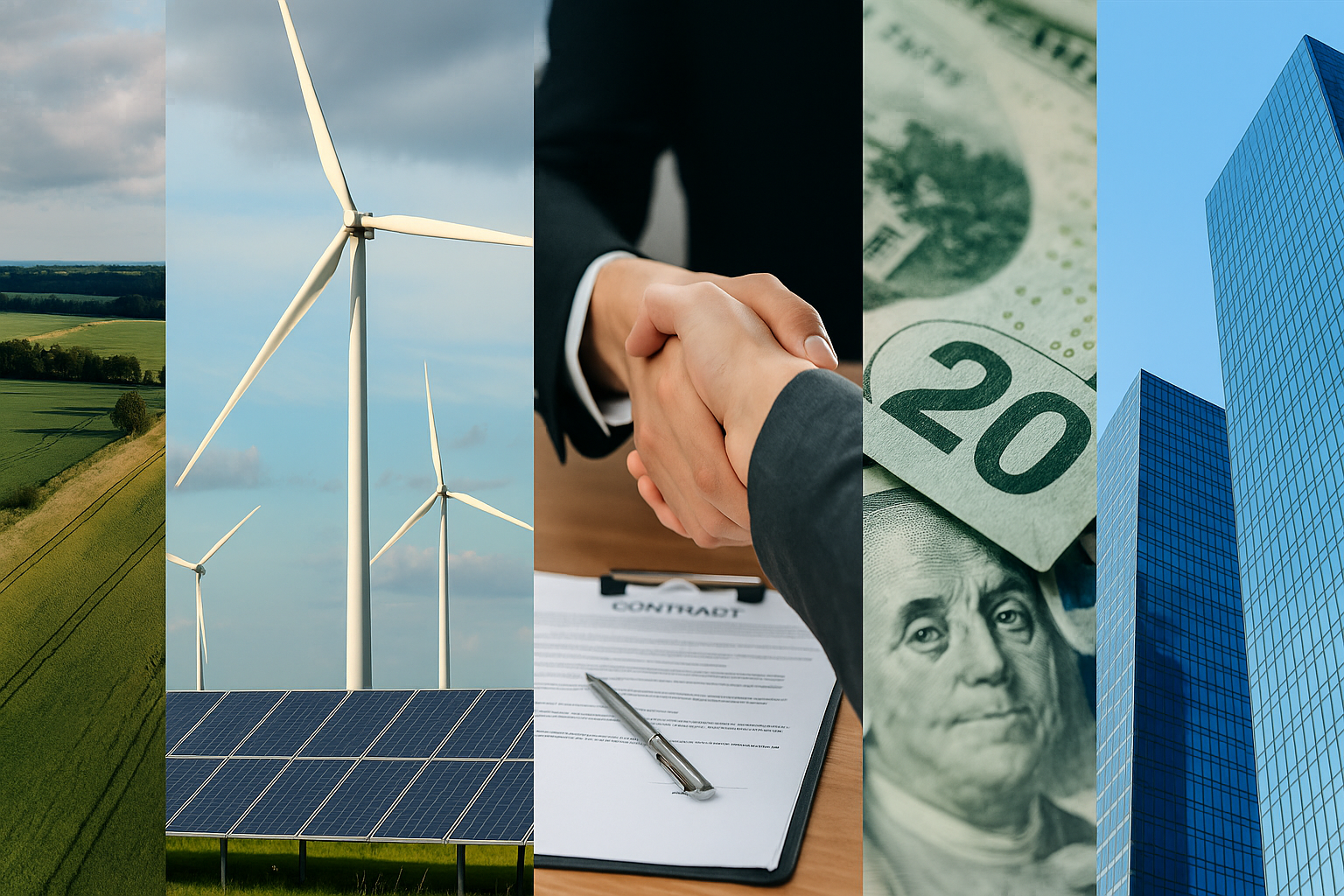
Investing In Renewables.
Renewable energy investment is entering a golden age. In 2025, Europe attracted approximately $75 billion in clean energy investments—including a record $40 billion in wind energy—driven by robust policy support and global shifts away from fossil fuels. At the same time, the U.S. has seen a sharp decline in wind sector investment, making Europe a more compelling destination for renewables capital . This surge reflects not just market momentum, but a deeper transformation: Windspace is uniquely positioned to develop bankable hybrid renewable projects (wind, solar, plus BESS) across Central Europe, offering investors both impact and stability.

Why Invest in Renewables Now
Investing in renewables today offers a compelling combination of strategic, financial, and geopolitical advantages. The EU’s ambitious REPowerEU and Net-Zero Industry Act are accelerating clean energy deployment while simplifying project approvals and offering de-risking mechanisms. At the same time, IRENA forecasts that the region could achieve 70% renewable electricity by 2030, provided infrastructure and investment accelerate rapidly.These developments create a stable environment for long-term returns—precisely what investors seek.
Types of Renewable Energy Investments
Renewable energy offers investors several pathways, each with distinct risk profiles, capital requirements, and return expectations. Understanding these options is essential to building a balanced green investment strategy:
a) Utility-Scale Wind & Solar Projects - These large-scale projects form the backbone of Europe’s energy transition. They offer long-term, stable returns backed by growing demand and government-backed energy targets. Windspace specializes in hybrid developments that integrate wind, solar, and BESS for improved output stability and higher grid value.
b) Hybrid RES + BESS Solutions - Adding Battery Energy Storage Systems (BESS) to renewable assets enables operators to store excess power and sell it when market prices peak, improving revenue predictability and grid balancing. This technology is becoming increasingly attractive to investors seeking risk-adjusted returns.
c) Corporate Power Purchase Agreements (PPAs) - Many corporations are committing to 100% renewable energy sourcing, driving demand for long-term PPAs. For investors, PPAs provide predictable cash flows and reduce exposure to wholesale market volatility.
d) Green Bonds & Infrastructure Funds - For those seeking diversified exposure, green bonds and funds provide access to renewable portfolios without direct project ownership. They are also aligned with ESG strategies, making them appealing to institutional investors.

Key Considerations Before Investing

Before committing capital to renewable energy projects, investors need to evaluate a broad set of factors that determine whether a project will move from concept to operation. Unlike other asset classes, renewables are highly dependent on physical conditions, regulatory frameworks, and community acceptance, which makes due diligence a critical step. Early analysis reduces uncertainty, minimizes risk, and ensures that projects can attract financing and achieve long-term profitability.
One of the first steps is conducting feasibility studies. These assess whether a site is suitable for development by examining wind or solar resource data, local land-use policies, and compatibility with surrounding infrastructure. In Central Europe, for example, rules often differ not only from country to country but also between regions, covering issues such as minimum distance from residential areas, noise thresholds, shadow flicker, and environmental protection zones. Without aligning the project design with these requirements, permitting can stall or even fail entirely.
Another key aspect is the availability of grid capacity. Even in high-resource areas, projects cannot move forward if transmission lines are saturated or grid operators cannot guarantee stable connections. Understanding the technical requirements of local grid operators and the potential cost of upgrades is essential for accurate financial modeling.
Finally, investors must consider the human and institutional dimensions of project development. Engaging with local communities, securing land agreements on fair and transparent terms, and complying with heritage, environmental, and aviation restrictions all contribute to smoother permitting and stronger social acceptance. Projects that are seen as respectful and responsible stand a much better chance of becoming operational assets. Core considerations to address before investing include:
- Regulatory compliance: Minimum distance to housing, noise limits, aviation authority approvals, environmental restrictions, and archaeological protections.
- Grid connection: Availability of transmission capacity, substation access, and potential grid reinforcement costs.
- Land acquisition: Securing land on fair terms that respect both landowners and community interests.
- Feasibility studies: Resource measurements (wind speed, solar irradiation), technical viability, and spatial planning checks.
- Permitting environment: Variations in timelines, transparency, and administrative requirements across EU countries.
- Community acceptance: Building trust with stakeholders to minimize opposition and delays.
- Bankability: Structuring projects to reduce risk and attract financing from banks and institutional investors.
Investment Models in Renewable Energy

Renewable energy investing offers several paths depending on the investor’s risk tolerance, capital structure, and desired level of involvement. Each model provides unique exposure to the clean energy transition — from full ownership of infrastructure to diversified financial instruments. Understanding these structures helps investors build portfolios that balance profitability, stability, and impact.
1. Direct Ownership and Operation
In this traditional model, investors acquire and operate renewable energy assets such as wind farms, solar parks, or hybrid RES + BESS systems. It offers the highest degree of control and long-term returns but also exposes investors to regulatory, construction, and operational risks. Many institutional investors prefer this model when partnering with experienced developers like Windspace, who can deliver ready-to-build or turnkey projects that meet strict bankability standards.
2. Greenfield Development vs. Brownfield Acquisition
A key distinction lies between developing projects from scratch (greenfield) and acquiring existing or operating assets (brownfield).
- Greenfield development involves early-stage engagement — land acquisition, permitting, design, and grid connection. It’s riskier but offers higher margins and strategic influence.
- Brownfield acquisition targets fully operational assets with established cash flow, ideal for investors seeking stable, predictable returns.
3. Infrastructure Funds and Private Equity
For investors who prefer indirect exposure, renewable infrastructure funds or private equity vehicles pool capital to finance multiple projects across technologies and regions. This model diversifies risk while leveraging professional management and technical expertise. Many funds now integrate hybrid RES projects and storage assets, reflecting growing investor confidence in flexible generation portfolios.
4. Green Bonds and Sustainable Finance Instruments
Investors seeking fixed-income exposure can choose green bonds, which fund renewable infrastructure while offering stable coupon payments. These instruments are often issued by utilities, development banks, or project developers, and they allow participation in the energy transition without operational involvement. The green bond market in Europe continues to expand rapidly, aligning with EU taxonomy and sustainability reporting standards.
5. Publicly Listed Companies
A more liquid entry point is investing through publicly listed renewable energy companies, such as developers, operators, or equipment manufacturers. Although subject to market volatility, they provide visibility, liquidity, and exposure to sector growth — particularly as renewable developers evolve into diversified energy platforms.
Risks and Mitigation Strategies
Even after permits are approved, many wind farms face significant grid connection delays, making this one of the most critical wind farm development challenges. In Europe, interconnection queues are increasingly congested, with hundreds of gigawatts of renewable capacity waiting for approval to connect to the transmission system.
Countries such as Germany, Spain, and Italy face particularly long lead times due to overloaded transmission networks and complex approval processes involving Transmission System Operators (TSOs), local network authorities, and national energy regulators. These delays create financial uncertainty, increase development risk, and can even threaten the viability of projects if Power Purchase Agreements (PPAs) are delayed.
To mitigate these risks, developers are adopting strategies such as early grid feasibility studies, proactive collaboration with TSOs, and innovative hybrid solutions combining wind energy with battery energy storage systems (BESS) to optimize grid usage and reduce congestion. Companies like Windspace integrate grid studies into the early stages of project planning, identifying cost-effective interconnection points and minimizing the risk of lengthy delays. Industry reports from WindEurope, ENTSO-E, and publications like Recharge News emphasize that addressing grid connection challenges early is essential for maintaining project timelines, reducing financial exposure, and ensuring renewable energy projects can reliably feed into national and regional power grids. By combining technical foresight, stakeholder engagement, and innovative grid solutions, developers can be helped in navigating one of the most persistent wind farm development issues in Europe.

Long-Term Outlook for Renewable Energy Investments
Financing large-scale wind projects remains one of the most complex and high-stakes wind farm development challenges, particularly in a landscape of rising interest rates, inflation, and evolving renewable energy policies. Utility-scale wind farms require significant upfront capital, often running into hundreds of millions of euros, making them highly sensitive to market volatility and regulatory uncertainty.
Common wind farm financing problems include securing debt and equity, structuring bankable investment models, and managing risks related to policy changes, such as alterations to feed-in tariffs, tax incentives, or subsidy schemes. To overcome these hurdles, developers often combine equity, debt, and government subsidies, while securing Power Purchase Agreements (PPAs) early to ensure revenue certainty.Partnerships with institutional investors, particularly those with an ESG focus, can provide additional stability and credibility.
Leading developers like Windspace adopt an integrated financing approach, collaborating with multiple financial institutions, investment funds, and energy off-takers to structure projects that remain profitable even under volatile conditions. Industry sources, including WindEurope, BloombergNEF, and Recharge News, frequently highlight the growing importance of innovative financial instruments, such as green bonds, structured project finance, and blended finance models, to mitigate investment risks.
By carefully aligning capital structure with regulatory compliance, technical feasibility, and market demand, developers can secure the necessary funding while minimizing financial exposure, ensuring the successful delivery of renewable energy projects across Europe.

Building a Sustainable and Profitable Portfolio
Investing in renewable energy is no longer a speculative bet; it has become a strategic component of resilient portfolios. As markets across Europe mature and regulations stabilize, investors are shifting from short-term gains to long-term value creation—aligning profit with impact.
A successful renewable investment strategy combines three essentials:
1. Technical and regulatory insight, ensuring that every project meets feasibility and compliance standards.
2. Financial structuring and risk management, turning complex assets into bankable opportunities.
3. Partnerships with experienced developers, who can secure land, grid access, and community support from day one.
At its core, renewable investment is about transforming capital into climate-positive infrastructure. Each megawatt built contributes to decarbonization, energy security, and regional development, while delivering stable returns in a sector driven by policy certainty and technological progress.
Windspace continues to develop and deliver bankable, large-scale hybrid projects—bridging investor capital with tangible environmental outcomes. By combining deep technical know-how with transparent cooperation, we help investors participate confidently in Europe’s energy transition—powering people and preserving the planet.
To better understand the practical aspects of renewable project development, explore our article on the key challenges in wind farm development and how they shape investment decisions in emerging European markets.




